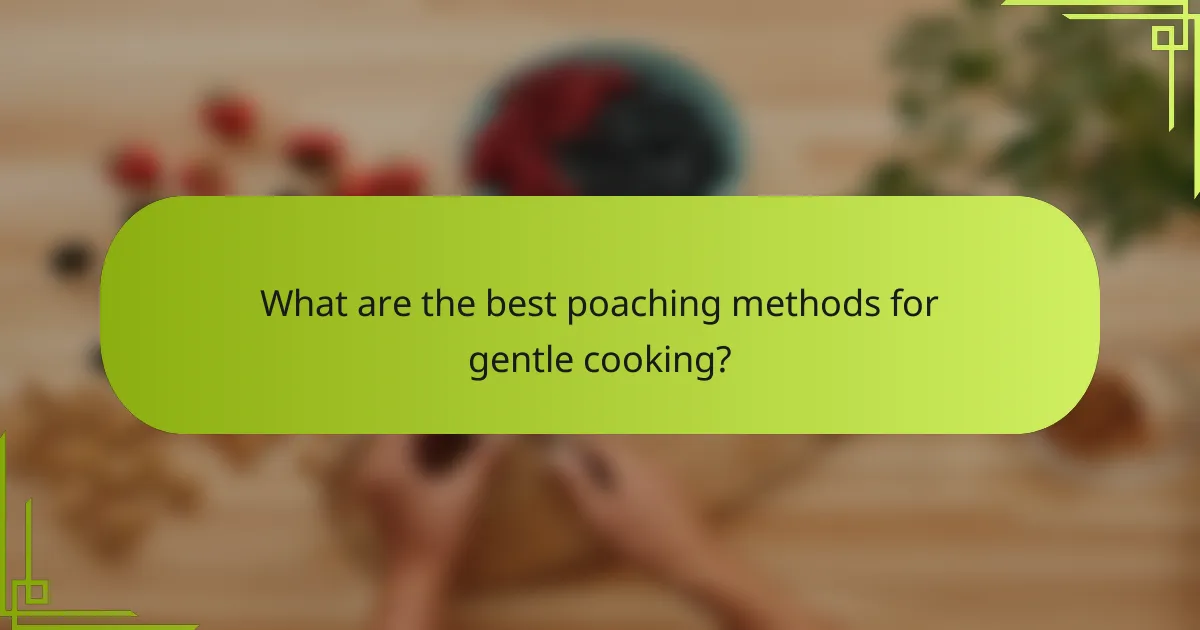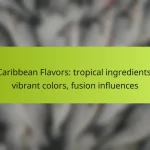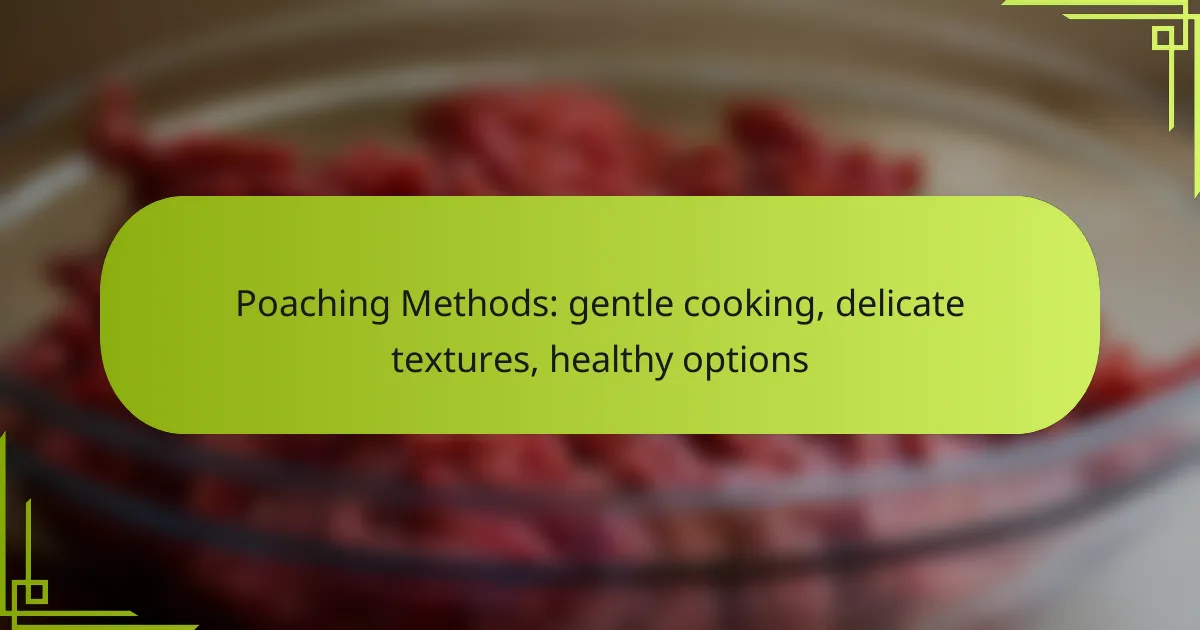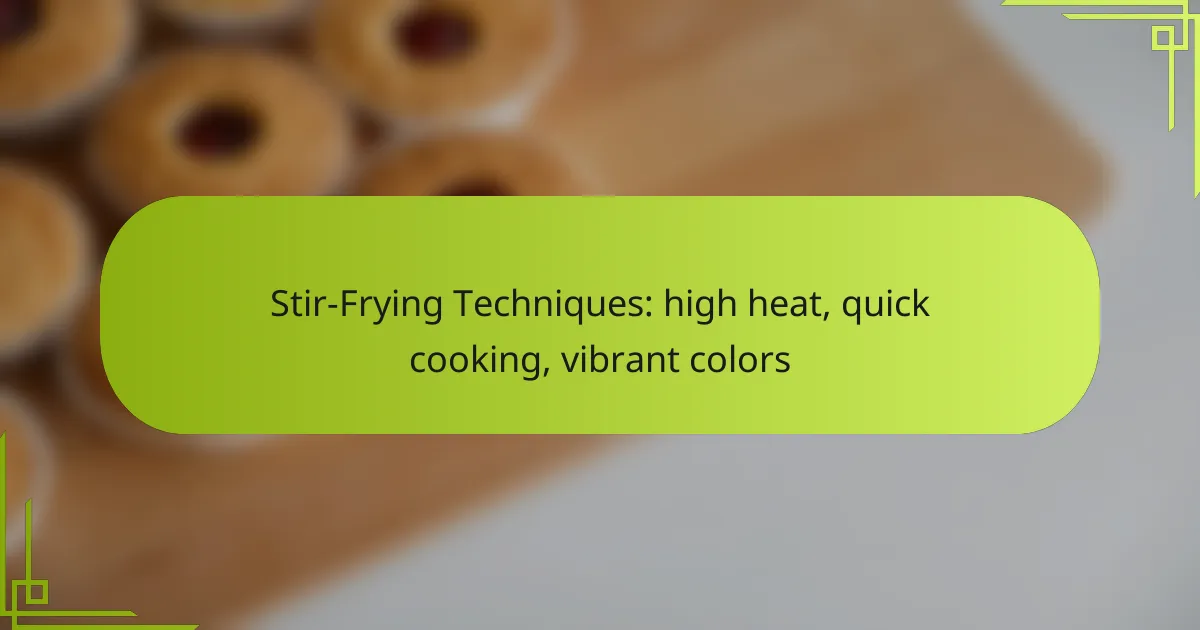Poaching is a gentle cooking method that enhances the natural flavors and textures of ingredients while keeping them moist and tender. By cooking food in a liquid at low temperatures, this technique allows for precise control over timing and temperature, resulting in delicate dishes that are both flavorful and healthy. Ideal for vegetables, fish, and poultry, poaching minimizes added fats and calories, making it a nutritious option for any meal.

What are the best poaching methods for gentle cooking?
The best poaching methods for gentle cooking include techniques that maintain delicate textures and enhance the natural flavors of the ingredients. These methods typically involve cooking food in a liquid at low temperatures, ensuring that the food remains moist and tender.
Water poaching
Water poaching is a straightforward method that involves simmering food in water or a flavored liquid at temperatures just below boiling. This technique is ideal for proteins like fish and eggs, as it allows for even cooking without toughening the texture.
To water poach, fill a pot with enough water to cover the food, add a pinch of salt, and bring it to a gentle simmer. Place the food in the pot and cook for several minutes, checking for doneness. Avoid boiling, as it can lead to a rubbery texture.
Steam poaching
Steam poaching combines the benefits of steaming and poaching, using steam to cook food gently while retaining moisture. This method is particularly effective for vegetables and fish, preserving their nutrients and flavors.
To steam poach, place the food in a steamer basket over simmering water, ensuring it does not touch the water. Cover the pot and steam for a few minutes until the food is cooked through. This method is quick and enhances the natural taste of the ingredients.
Broth poaching
Broth poaching involves cooking food in a flavorful broth, adding depth to the dish. This method is excellent for proteins like chicken or fish, infusing them with rich flavors while keeping them moist.
To broth poach, bring a pot of broth to a gentle simmer, then add the food. Cook until done, typically around 10-15 minutes for chicken breasts, depending on thickness. This technique can be enhanced with herbs and spices for additional flavor.
Wine poaching
Wine poaching uses wine as the cooking liquid, imparting a unique flavor profile to the food. This method works well for fruits and certain proteins, creating a sophisticated dish with minimal effort.
To wine poach, choose a dry white or red wine, and bring it to a simmer in a pot. Add the food and cook gently for several minutes. For fruits like pears, consider adding sugar and spices to the wine for a dessert option.
Citrus poaching
Citrus poaching involves cooking food in a citrus-infused liquid, which brightens flavors and adds a refreshing twist. This method is particularly suitable for fish and fruits, enhancing their natural sweetness.
To citrus poach, combine water with citrus juice and zest in a pot. Bring to a simmer, then add the food and cook until tender. This technique not only adds flavor but also helps in tenderizing the food, making it a versatile option for various dishes.

How to achieve delicate textures in poached foods?
To achieve delicate textures in poached foods, focus on maintaining a gentle cooking environment that preserves the integrity of the ingredients. Proper temperature control, precise timing, and thoughtful ingredient selection are essential to ensure that the final dish is tender and flavorful without being overcooked.
Temperature control
Temperature control is crucial for poaching, as it prevents ingredients from becoming tough or rubbery. The ideal poaching temperature typically ranges from 160°F to 180°F (70°C to 82°C). Using a thermometer can help maintain this range, ensuring that proteins like fish and poultry remain moist and tender.
When poaching, avoid boiling, as high temperatures can lead to a loss of texture. Instead, aim for a gentle simmer, where small bubbles occasionally break the surface. This method allows for even cooking while preserving delicate textures.
Timing precision
Timing is essential when poaching, as even a minute too long can alter the texture of your food. Generally, fish may require only 10 to 15 minutes, while chicken breasts can take around 15 to 20 minutes, depending on thickness. Use a timer to ensure you don’t exceed the recommended cooking times.
To check for doneness, use a fork to gently flake the food. It should be opaque and easily separate. If you’re unsure, it’s better to undercook slightly, as the food will continue to cook in the residual heat after being removed from the poaching liquid.
Ingredient selection
Choosing the right ingredients is vital for achieving delicate textures in poached dishes. Fresh, high-quality proteins such as fish, chicken, or eggs will yield better results than older or frozen options. Additionally, consider using ingredients with natural moisture, as they will enhance the overall tenderness.
Herbs, spices, and aromatics can also play a significant role in flavoring the poaching liquid, which in turn affects the texture of the food. For example, poaching fish in a broth infused with lemon and dill can enhance both taste and texture, making the dish more enjoyable.

What are the healthiest poaching options available?
The healthiest poaching options include methods that preserve the natural flavors and nutrients of food while minimizing added fats and calories. Techniques such as poaching vegetables, fish, and poultry are excellent choices for creating nutritious meals.
Vegetable poaching
Vegetable poaching involves gently cooking vegetables in simmering water or broth, which helps retain their vitamins and minerals. Common vegetables for poaching include asparagus, carrots, and spinach, which typically require only a few minutes of cooking time.
To poach vegetables effectively, cut them into uniform sizes for even cooking. Consider adding herbs or spices to the poaching liquid for enhanced flavor without extra calories. Avoid overcooking to maintain crispness and vibrant colors.
Fish poaching
Fish poaching is a healthy cooking method that uses simmering liquid, such as water, broth, or wine, to cook fish gently. This technique is ideal for delicate fish like salmon, cod, and trout, which can become dry if overcooked.
When poaching fish, aim for a water temperature of around 160-180°F (70-82°C). Cooking times vary based on thickness, but generally, fish should be poached for about 10 minutes per inch of thickness. Use aromatic ingredients like lemon, dill, or bay leaves in the poaching liquid for added flavor.
Poultry poaching
Poultry poaching involves cooking chicken or turkey in a flavorful liquid, which helps keep the meat moist and tender. This method is particularly useful for lean cuts, such as chicken breasts, which can dry out with other cooking methods.
To poach poultry, submerge the meat in a mixture of water and seasonings, bringing it to a gentle simmer. Cook for approximately 15-20 minutes, depending on the size of the pieces. Ensure the internal temperature reaches at least 165°F (74°C) for safety. Pair with fresh herbs or vegetables in the poaching liquid for a nutritious boost.

What equipment is needed for poaching?
To successfully poach food, you need specific equipment that helps maintain gentle cooking temperatures and delicate textures. Essential tools include poaching pans, thermometers, and steamer baskets, each serving a unique purpose in the poaching process.
Poaching pans
Poaching pans are designed with a wide, shallow shape that allows for even heat distribution and easy access to the food. Look for pans with a lid to help retain moisture and maintain a consistent temperature during cooking. Non-stick surfaces can also be beneficial for easy food release and cleanup.
When selecting a poaching pan, consider materials like stainless steel or enameled cast iron, which provide good heat conduction. A typical size ranges from 2 to 4 quarts, accommodating various portions of food.
Thermometers
A reliable thermometer is crucial for poaching, as it ensures that the cooking temperature remains within the ideal range, typically between 160°F to 180°F (70°C to 82°C). Digital instant-read thermometers are particularly useful for quickly checking the temperature of the poaching liquid.
For precision, consider using a probe thermometer that can remain in the pot while cooking. This allows you to monitor the temperature without lifting the lid, which can disrupt the cooking process.
Steamer baskets
Steamer baskets can be a valuable addition to your poaching setup, especially for delicate foods like fish or vegetables. They allow food to be suspended above the poaching liquid, preventing direct contact while still benefiting from the steam’s gentle heat.
Choose a steamer basket that fits your pot snugly and is made of materials that can withstand high temperatures. Bamboo or stainless steel options are popular, and they can help maintain the food’s texture and flavor without the risk of overcooking.

What are the benefits of poaching over other cooking methods?
Poaching offers several advantages compared to other cooking techniques, primarily through its gentle approach that preserves the integrity of ingredients. This method results in healthier meals with lower fat content, retained nutrients, and enhanced flavors, making it an excellent choice for various dishes.
Lower fat content
Poaching typically requires little to no added fats, which significantly reduces the overall fat content of the dish. Instead of frying or sautéing, ingredients are submerged in simmering liquid, allowing them to cook without the need for oil or butter.
This method is particularly beneficial for those looking to maintain a healthy diet or reduce calorie intake. For example, poached chicken or fish can be a lean alternative to fried options, providing a satisfying meal with fewer calories.
Retained nutrients
One of the key benefits of poaching is the preservation of nutrients that can be lost through other cooking methods. Since poaching involves cooking at lower temperatures and shorter times, vitamins and minerals remain intact, contributing to a more nutritious meal.
For instance, vegetables poached in water or broth retain more of their vitamins compared to those that are boiled or roasted. This makes poaching an ideal method for preparing healthy side dishes or incorporating vegetables into main courses.
Enhanced flavors
Poaching allows for the infusion of flavors into the food, as the gentle cooking process enables ingredients to absorb the essence of the poaching liquid. Using flavorful broths, wines, or herb-infused liquids can elevate the taste of the dish significantly.
For example, poaching fish in a court bouillon or chicken in a savory broth can create a depth of flavor that enhances the overall dining experience. This method is particularly effective for delicate proteins, ensuring they remain moist while absorbing complementary flavors.

How to select the right ingredients for poaching?
Selecting the right ingredients for poaching is crucial for achieving delicate textures and enhancing flavors. Focus on freshness, quality, and compatibility with the poaching liquid to ensure a successful dish.
Freshness criteria
Freshness is key when choosing ingredients for poaching, as it directly impacts flavor and texture. Look for ingredients that are in season and sourced locally, as they tend to have better taste and nutritional value.
For fish, check for clear eyes, firm flesh, and a mild scent. For fruits and vegetables, select those that are vibrant in color and free from blemishes. A good rule of thumb is to use ingredients that have been harvested within the last few days.
When purchasing poultry or meat, ensure they are from reputable sources. Look for labels indicating freshness, such as “farm-raised” or “organic,” and avoid products that have been frozen for extended periods, as they may lose quality during thawing.










